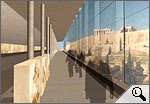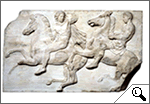|
|
|
 |
 |
 > The Acropolis of Athens > The Parthenon… > ...Marbles dimarts, 23 d'octubre de 2007
The Acropolis of Athens, one of the great collections of monuments from antiquity and a site of renowned artistic and cultural quality, is in the headlines. In the middle of October, hundreds of pieces (mostly sculptures) began their journey to the New Acropolis Museum, designed by the Swiss architect Bernard Tschumi and expected to be opened next year.
In contrast to the old museum that was located within the Acropolis itself, the new museum is not far from the Greek capital's famous hill, being just four hundred meters lower down. If all goes according to plan, the move, which is insured for €400 million and is scheduled to take six weeks, may be completed by the end of November. This will be the first time in 2500 years that the objects leave their original site, observed Michalis Liapis, the Greek Minister of Culture, who took the opportunity of the start of the move to call again for the return of the Parthenon Marbles (taken from the Parthenon, the Acropolis' most famous monument), also known as the 'Elgin Marbles', which have been housed in the British Museum for two centuries. Greece is confident that these events will provide a renewed boost to the campaign to restore the marbles currently being kept in London. In fact, the New Acropolis Museum will include a rectangular glass gallery set aside for the sculptures.
The Acropolis of AthensLocated on a plateau 100 metres above the city, the Acropolis is a symbol of Ancient Greece and of the whole of Western civilisation. In the middle of the 5th century BC, Pericles, the politician who consolidated Athenian democracy, was responsible for rebuilding the religious site. He put the sculpture and painter Phidias in charge of the works. With the help of the best artists of the time, Phidias turned the Acropolis into a place of beauty. Of the remains that have been preserved, the Ionic temple of Erechtheion, with its famous Caryatid porch, stands out as does the Old Propylon (which served as an entrance to the site), the Temple of Athena Nike (built on a bastion along the wall) and, of course, the Parthenon.
The Parthenon…The Parthenon is a masterpiece of Greek art from the Classical age. In a Doric style (the most austere of the Greek architectural schools), the Parthenon was made out of Pantelic marble and dedicated to Athena, the goddess of wisdom and the patron saint of Athens. Successively a church, mosque and then gunpowder arsenal, part of the Acropolis was destroyed by a bombardment 1687. At the beginning of the 19th century, Lord Elgin, the British ambassador to the Ottoman Empire (to which Greece belonged at the time), took a large part of the sculptures with him after they were sold to the British government in 1816. Since then they have been on display in the British Museum.
...MarblesGreece is demanding the return of the marbles being kept in London, a request that has the support of a number of organisations and, also (according to opinion polls) the majority of the British public. The Greek government believes it is only right that the marbles be returned and the construction of the New Acropolis Museum reinforces still further arguments for their return. On the other hand, the British Museum argues that the aim of the museum is to become an international museum that displays the great cultural achievements of humanity, something that, in the eyes of the British Museum, justifies it housing the marbles.
|
Investiga

> Cop d'ull al Nou Museu de l'Acròpoli d'Atenes.

> Imatges del trasllat de les peces escultòriques al nou museu.

> L'acròpoli i Atenes: galeria fotogràfica.

> Marbres reunits: reconstrucció a base de les escultures guardades a Atenes i a Londres.
I també...
- 'Els marbres de la discòrdia' (article del 2004).
- L'Acròpoli d'Atenes, a l'antiguitat i ara.
- Vista panoràmica del Partenó.
- L'antiga Grècia, didàcticament explicada.
Portada |
Europa Press |
El Punt |
La premsa |
Especials |
Diari de l'escola |
LesFinances.info |
Editorials |
Mail obert |
Els blocs |
Lletres
Tecnologia i ciència | Solidaritat | Cap de 7mana | Campus | El 9 | Presència | Fòrums | Enquestes | Xat | Correu
Traductor | Edicions en Pdf | Wap-pda | Biblioteca | Lletra més grossa
Tecnologia i ciència | Solidaritat | Cap de 7mana | Campus | El 9 | Presència | Fòrums | Enquestes | Xat | Correu
Traductor | Edicions en Pdf | Wap-pda | Biblioteca | Lletra més grossa
| Què és VilaWeb? Publicitat Mapa web Contacte | Una web de Partal, Maresma i Associats, S.L. |




